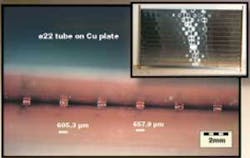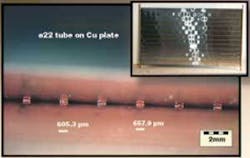Welding thermal solar absorbers
In the production of flat thermal solar panel absorbers, laser welding offers flexibility and drastically reduces the risk for damaging the coating
Ulrich Duerr
The increase in oil prices due to the uncertain political and supply situation and the CO2 goals of the Kyoto protocol will strengthen the general demand for “green” energy, one source of which is solar energy. Several countries have already implemented political measures to increase acceptance and use of solar energy.
The simplest way to use solar energy is to collect the solar radiation energy, convert it into heat, and subsequently heat a liquid that can be stored and distributed, for example, in building facilities. These thermal solar collector systems typically consist of flat collectors or vacuum tube collectors, proper pipelines, and a storage tank. A heat management system optimizes the use and coordination with other energy sources.
Principle of thermal solar collectors
There are various strategies for collecting solar energy and transforming it into heated liquids.1 Figure 1 shows a thermal solar panel on the base of flat thermal solar collectors. The core is the selectively coated metallic absorber. The coating absorbs most of the radiation (95 percent) but reemits as little infrared radiation as possible (5 percent at 100o C).The absorbed radiation is converted to heat, which has to be transferred with high efficiency to the liquid in the register tubes. Presently, the metal sheet is made of copper because of its excellent heat conductivity. The thickness of the copper sheet is typically 0.2 mm. Increasing copper prices require alternatives, which, at the moment, includes selectively coated pure aluminum sheets2 that have at 20o C a heat conductivity of 220W/mK compared to copper at 384W/mK. The heat conductivity of other aluminum alloys is even smaller and there is a risk of reduced metallurgical quality leading to reduced mechanical resistance after welding. To compensate for the lower heat conductivity of pure aluminum the thickness of the sheets is increased. In standard flat collector panels copper tubes are thermally and mechanically attached to the sheet. The heated liquid (normally water with ingredients to decrease the freezing temperature and increase the boiling point) in the register tubes is pumped via the main water pipes to the users or stored in a water tank. To ensure high efficiency the heat transfer from the register tubes to the liquid has to be optimized with respect to the flow of the chosen liquid. A turbulent flow shows a more efficient heat transfer but requires a greater pressure differential for the same flow as a laminar flow. Meander type flow tube arrangements on the thermal absorber have some advantage in this respect. Thermal loss mechanisms like heat transfer to the surrounding material and air have to be minimized by proper thermal insulation strategies.
null
Why laser?
The proper thermal and mechanical joining of the water-carrying register tubes to the absorber sheet is essential for the efficiency of the solar absorber. This joining has to fulfill several requirements, including:
- High heat conductivity
- High mechanical strength to withstand the temperature gradients and thermal expansion
- Little thermal damage of the absorber coating for accepted visual appearance
- Little thermally induced deformation of the absorber sheet
- No corrosion to offer long lifetime
- High production speed
- High process reliability and reproducibility
- Easy integration of the process in production system
- Cost efficiency
The process of choice is welding or soldering. Soldering has some limits due to the high temperatures of >220o C measured under certain operating conditions (stagnation),3 environmental requirements, and corrosion risks. When welding, ultrasonic welding systems or pulsed Nd:YAG solid-state welding systems are used. Laser welding offers a more flexible, non-contact procedure with a high production rate and very good quality. However, the investment costs for a laser system are higher compared to the ultrasonic systems.
Two-sided laser spot welding (see Figure 2) fulfills most of the mentioned requirements. Note that the welded spots are not on the contact line between the tube and the flat absorber sheet. So, in principle, one has three heat transfer areas in laser spot welding.
The heat conductivity is given by the spatial separation of the spot welds along the welding line. This distance is between 1 and 3 mm. Smaller separations are not recommended because the productivity goes down due to the limited pulse repetition rate of the laser source, and there is an increasing risk for thermally induced deformation of the absorber sheet. The latter can be reduced by proper welding strategies.
The mechanical strength of the joining, like shear and pull resistance, also depends on the density of the spot welds. There are >20,000 welding points on a typical absorber panel.3 In the combination Cu-Cu the joining has a similar mechanical resistance as the base material. In the combination Cu (tube)-Al (sheet) the resistance of the joining is weaker and depends on the type of alloy and the resulting metallurgy. The risk of corrosion for two different metals in contact and exposed to humidity has to be addressed. Electrochemical corrosion of the Al absorber sheet is reduced by an anti-corrosion layer.2 During laser welding high-temperature chemical reaction with air leads to a protecting aluminum oxide layer. Forced aging tests in compliance with ISO have confirmed the effectiveness of these processes.2 As Cu and Al have different heat expansion coefficients (Al: 23.8 10-6/K; Cu: 16.8 10-6/K at 20 degrees), the Cu tube and Al sheet have to be pressed together in the area where the welding is performed to avoid excessive deformation of the Al absorber sheet.
Damage of the selective coating opposite to the welding side is minimized by optimizing the necessary welding energy of the laser pulse and the pulse duration for every material combination and geometrical configuration of the panel (see Figure 2). The smaller the irradiation angle with respect to the sheet surface the more efficient the welding is and less pulse energy is necessary. For the Cu-Cu combination the necessary pulse energy is typically 8 J for an angle of incidence of 20 degrees. The pulses are short (<1 ms) to reduce heat conduction losses. Due to the more favorable material and absorption properties of aluminum, the combination Al-Cu needs less than 5J under the same irradiation conditions. For a high average power laser this allows a pulse repetition rate that leads to a production speed of about 9 m/min for one row of spots separated by 2 mm. Laser are available that enable welding both sides of the tubes with the same speed using energy share optics.
Experiments have shown that the pulse energy can be reduced with smaller angles of incidence of the laser beam. Register tubes with a small diameter and a focused beam with a small cone angle (numerical aperture) are therefore to be preferred. In laser production systems optical fibers are normally used to guide the laser radiation to the welding station. With a numerical aperture of NA =0.11 of the fiber, the irradiation angle can be reduced to approximately 10 degrees for a typical distance of the register tubes of 100 mm. In this configuration the production speed can be increased by more than 20 percent compared to the values mentioned above. This decrease in spot welding energy is understandable when looking at Figure 2. The smaller the angle is the smaller the gap that has to be bridged and consequently less material has to be melted for the joining. Also note that the joining is moving towards the contact line between tube and sheet when decreasing the irradiation angle. In addition modern pulsed solid-state Nd:YAG lasers offer temporal pulse shaping to optimize the welding process.3 For a given irradiation angle an additional degree of freedom for optimizing the required welding energy is the position of the focal spot. Optimizing the welding pulse energy also will stabilize the process and minimize the thermal side effects.
Production system
Automated welding systems for customized absorber designs are currently offered for complete thermal absorbers or for fins. Figure 3 shows a portal production system for complete full plate thermal solar absorbers. Typical dimensions of the sheets are 1200 x 2000 mm. Designs may vary from meander type bended single tubes to a concept where 10-12 straight register tubes are connected with the entrance and exit header pipes on a panel. To make the welding reliable and reproducible the tubes have to be in contact with the absorber sheet and positioned within a few hundreds of micrometers relative to the focus position of the laser beam. This problem is solved in actual production systems. At the moment the failure rate for the spot weld is <200 ppm4 even with the more complex meander tubes. To increase the production rate to more than 20 absorbers/hour not only the welding process has to be optimized but the handling and-depending on the absorber design-the positioning time of the welding optics when moving from one tube to the other or when following the meander curves.null
Summary
Thermal flat Cu-Cu or Al-Cu solar absorbers that meet the requirements of thermal efficiency and mechanical resistance can be welded reliably and reproducibly at high production speed with pulsed Nd:YAG laser systems. Especially for the more economic Cu-Al combination, the laser welding seems to offer improved reliability of the process and a minimum of corrosion risks compared to other joining methods.
References
1. www.solarbuzz.com and other Internet homepages.
2. mirotherm®, www.alanod.com.
3. Dürr,U et. al , “Advanced welding strategies with pulsed Nd;YAG lasers,” Proceedings of the 23rd ICALEO 2004.
4. Communication, www.kbb-solar.com.
5. www.sunlaser.ch.
Ulrich Duerr ([email protected]) is the manager of market development, innovation & technology, at Lasag, Switzerland (www.lasag.com).



